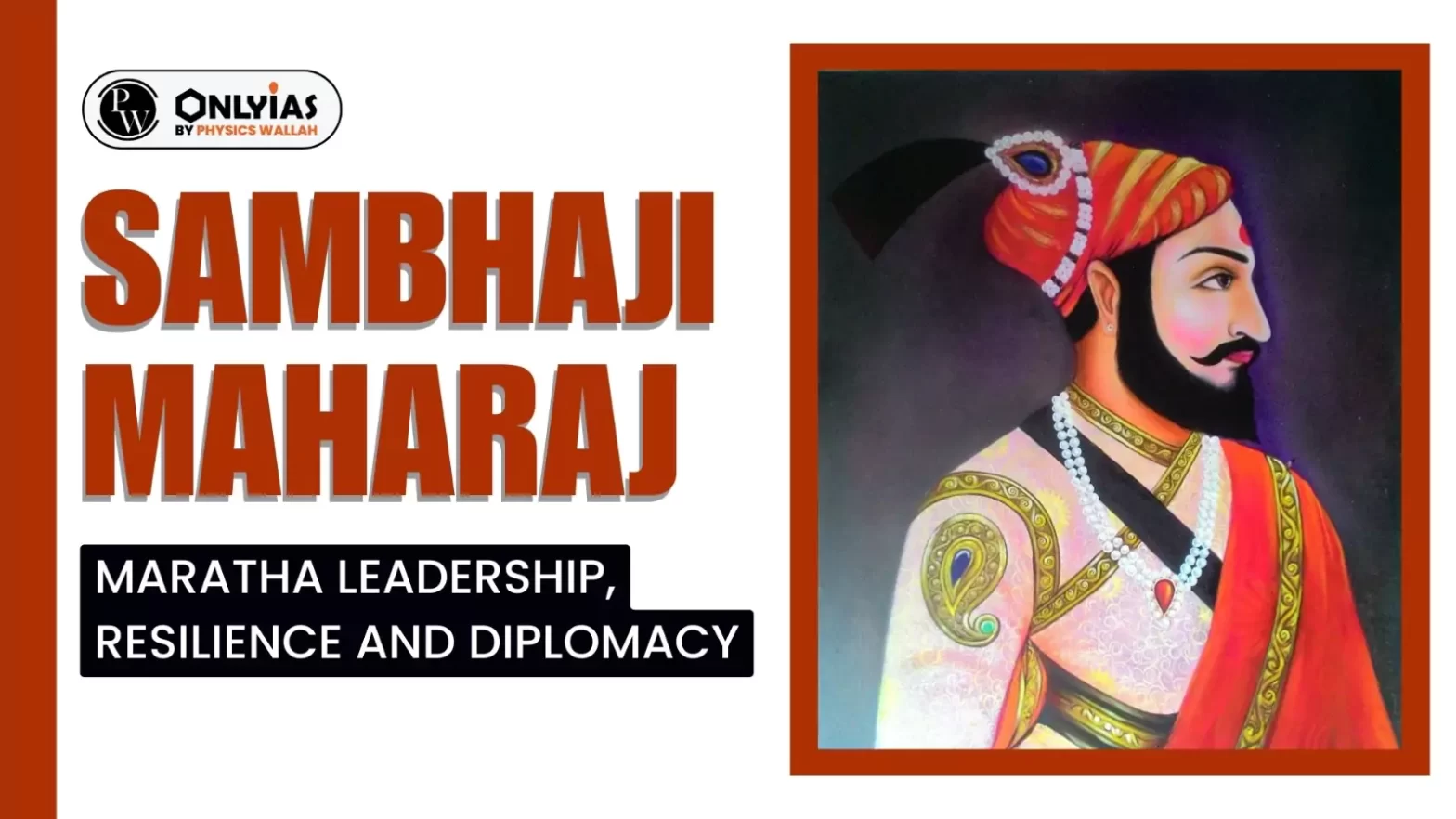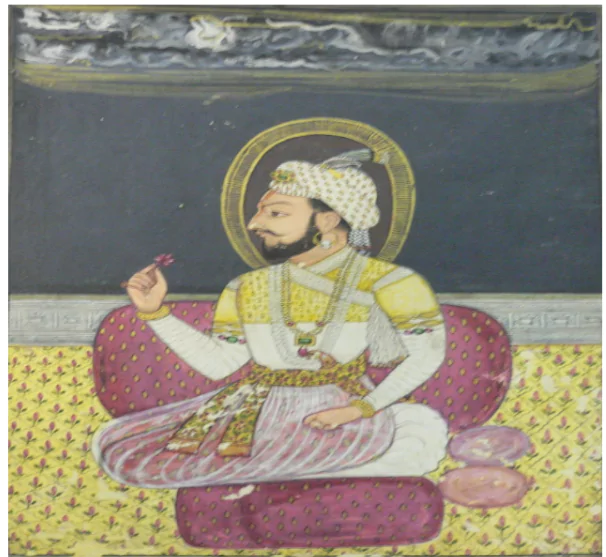![]() PWOnlyIAS
PWOnlyIAS
![]() May 15, 2024 04:00
May 15, 2024 04:00
![]() 1438
1438
![]() 0
0
Know about Chhatrapati Sambhaji Maharaj, a fearless Maratha ruler known for his leadership, resilience, and enduring sacrifice. Delve into his life, triumphs, and legacy in this comprehensive exploration.

The life and legacy of Chhatrapati Sambhaji Maharaj, the valiant Maratha ruler known for his leadership, diplomatic prowess, and enduring sacrifice.

A portrait of Chatrapati Sambhaji Maharaj
Sambhaji Raje Bhosale, known as Chhatrapati Sambhaji, was frequently referred to as Shambhu Raje, one of his well-known Marathi titles. Second Maratha ruler, revered by the people of India, particularly in Maharashtra, he earned the epithet “Dharamveer” for his unwavering devotion, love, and sacrifices for the Hindu Dharma. Considered by many as the most formidable Maratha monarch following the reign of Chhatrapati Shivaji Maharaj, Sambhaji Raje Bhosale left an indelible mark on history.
| Aspect | Details |
| Full Name | Sambhaji Bhosale |
| Birth | May 14, 1657 |
| Birthplace | Purandar Fort, near Pune, Maharashtra, India |
| Parents | Shivaji Maharaj (Father), Saibai Nimbalkar (Mother), After his mother’s death, his paternal grandmother Jijabai looked after him. |
| Reign | July 20, 1680 – March 11, 1689 |
| Dynasty | Maratha Empire |
| Coronation | July 20, 1680, at Raigad Fort |
| Predecessor | Shivaji Maharaj |
| Successor | Rajaram Maharaj |
| Coronation | On June 6th, 1674 at the time of the coronation of Shivaji Maharaj, he was declared the prince of the Sovereign Maratha Kingdom. |
| Major Battles | Battle of Burhanpur (1681): Successful Maratha raid on the Mughal garrison. |
| Campaigns in Konkan (1683-1684): Continued resistance against Siddis and Portuguese. | |
| Siege of Ramsej (1682-1688): Prolonged defense against Mughals, notable for Maratha resilience. | |
| Battle of Wai (1687): Fought against Mughal forces under Prince Azam. | |
| Battle of Bhupalgarh (1687): Key engagement against Mughal forces. | |
| Marital Status | Married to Yesubai |
| Children | Shahu I (son) |
| Notable Achievements | Expanded the Maratha Empire; naval engagements against the Siddis and Portuguese; continued father’s policies and administration. |
| Death | March 11, 1689 |
| Place of Death | Tulapur, near Pune, Maharashtra, India |
| Cause of Death | Executed by the Mughal Emperor Aurangzeb |
| Legacy | Remembered for his bravery, resistance against Mughal oppression, and contribution to the Maratha Empire. |
Chhatrapati sambhaji maharaj was born on May 14, 1657, at Purandar Fort, near Pune, in Maharashtra, India. He was the eldest son of Shivaji Maharaj, the founder of the Maratha Empire, and his first wife, Saibai Nimbalkar. Every year on 14 May India observed his birthday as Chhatrapati Sambhaji Maharaj Jayanti.
Sambhaji’s early years were marked by a combination of royal privilege and rigorous training. His mother, Saibai, passed away when he was just two years old, which deeply affected his childhood.
At the age of nine, Sambhaji was sent to live as a political hostage at the Mughal court of Emperor Aurangzeb as part of a peace treaty of Purandar.
Sambhaji Maharaj’s life was significantly marked by family disputes and political estrangement, initially arising from tensions within the Maratha royal family. After the death of his mother, Saibai, Sambhaji’s relationship with his stepmother, Soyarabai, became strained. Soyarabai favored her own son, Rajaram, and sought to place him in a position of power, which led to a rivalry between Sambhaji and Rajaram.
Despite internal challenges, Sambhaji’s actions and strategic ability enabled him to overcome the conspiracies and secure his position as the ruler. His coronation not only symbolized the continuity of Shivaji’s legacy but also emphasise the critical need for strong and unified leadership to defend and expand the Maratha Empire amidst external threats and internal discord.
From imprisonment to gaining throne Sambhaji has developed various quality and took various decisive decision to rule the Maratha Kingdom efficiently. Some of the qualities and decisions are:
The frequent battles and strategic conflict between the Marathas and Mughals not only highlighted Sambhaji’s unwavering resilience and military skill but also exposed the complexities of Mughal warfare.
The Maratha-Portuguese conflict during Sambhaji Maharaj’s reign was a significant chapter in the Maratha Empire’s history. As the Marathas sought to expand their influence along the western coast of India, they frequently clashed with the Portuguese, who controlled key coastal territories and trade routes.
Under Sambhaji reign various political and administrative reform taken place some of these are:
In early 1689, Sambhaji called his commanders for a strategic meeting at Sangameshwar in Konkan. In a meticulously planned operation, Ganoji Shirke (brother of Sambhaji’s wife Yesubai) and Aurangzeb’s commander, Mukarrab Khan, attacked Sangameshwar when Sambhaji was about to leave the town. A small ambush followed, and Sambhaji was captured by Mughal troops on 1 Feb, 1689. He and his advisor, Kavi Kalash, were taken to Bahadurgad.
After capture they were brought face to face with Aurangzeb, the latter offered to let Sambhaji live if he surrendered all the Maratha forts, turned over all his hidden treasures, and disclosed the names of all the Mughal officers who had helped him. Sambhaji refused, and instead sang the praises of Mahadev (Lord Shiva). Aurangzeb ordered him and Kavi Kalash to be tortured to death. Sambhaji and Kavi Kalash were brutally tortured for over a fortnight. On March 11, 1689, Sambhaji was killed, reportedly by tearing him apart from the front and back with ‘Wagh Nakhe’ (‘Tiger claws’, a kind of weapon), and was beheaded with an axe.
This grievous death was given to him at Vadhu on the banks of the Bhima River, near Pune. Residents of the nearby village named ‘Vadhu’ collected as many pieces of his body as they could find, sewed them together, and performed the final rites on his body. These villagers later went on to use the surname ‘Shivle’ or ‘Shivale‘, as per spelling preference, which means ‘sewing’ in the Marathi language.ich means ‘sewing’ in the Marathi language.
Following the death of Sambhaji Maratha empire fall into the state of turmoil and mismanagement like:
Some of the historical judgement and remarkable decision took place by Sambhaji during his kingdom some of the reform are:
| Also Read | |
| First Anglo Maratha War | Aurangzeb Biography |
| Chhatrapati Shivaji Maharaj Biography | THE RISE OF MARATHAS |
Known for his bravery, Sambhaji Maharaj was a complex figure whose reign was marked by both triumphs and challenges. He demonstrated military prowess, expanded the Maratha Empire, and fiercely defended his kingdom against Mughal incursions. However, his reign was also marred by internal strife, political intrigue, and conflicts with neighboring powers. Despite facing significant adversity, Sambhaji’s legacy endures as a symbol of resilience, leadership, and determination in the face of adversity.
| Must Read | |
| NCERT Notes For UPSC | UPSC Daily Current Affairs |
| UPSC Blogs | UPSC Daily Editorials |
| Daily Current Affairs Quiz | Daily Main Answer Writing |
| UPSC Mains Previous Year Papers | UPSC Test Series 2024 |
<div class="new-fform">
</div>

Latest Comments